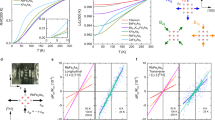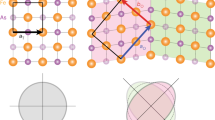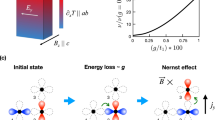Abstract
In most unconventional and high-temperature superconductors, superconductivity emerges as a nearby symmetry-breaking phase is suppressed by chemical doping or pressure1,2,3,4,5,6,7. This has led to the belief that the fluctuations associated with the symmetry-breaking phase are beneficial, if not responsible, for the superconducting pairing8,9. A direct test to verify this hypothesis is to observe a decrease of the superconducting critical temperature (Tc) by applying the symmetry-breaking conjugate field that suppresses the dynamic fluctuations of the competing order. However, most of the competing phases in unconventional superconductors break translational symmetry, requiring a spatially modulated conjugate field that is difficult to realize experimentally. Here, we show that anisotropic strain, the conjugate field of nematicity, reduces the Tc of an iron pnictide. For optimally doped samples we show a fivefold reduction of Tc with less than one per cent of strain. For underdoped samples, Tc becomes zero yielding a fully metallic ground state. In addition to providing direct evidence of the role played by the nematic fluctuations in the formation of the superconducting state, these results demonstrate tunable mechanical control of a high-temperature superconductor, an important step forward for technological applications of superconductivity.
This is a preview of subscription content, access via your institution
Access options
Access Nature and 54 other Nature Portfolio journals
Get Nature+, our best-value online-access subscription
$29.99 / 30 days
cancel any time
Subscribe to this journal
Receive 12 print issues and online access
$209.00 per year
only $17.42 per issue
Buy this article
- Purchase on Springer Link
- Instant access to full article PDF
Prices may be subject to local taxes which are calculated during checkout




Similar content being viewed by others
Data availability
The data that support the plots within this paper and other findings of this study are available from the corresponding author upon reasonable request. Source data are provided with this paper.
References
Gegenwart, P., Si, Q. & Steglich, F. Quantum criticality in heavy-fermion metals. Nature 4, 186–197 (2008).
Stewart, G. R. Heavy-fermion systems. Rev. Mod. Phys. 56, 755–787 (1984).
Han, G. H., Duong, D. L., Keum, D. H., Yun, S. J. & Lee, Y. H. van der Waals metallic transition metal dichalcogenides. Chem. Rev. 118, 6297–6336 (2018).
Manzeli, S., Ovchinnikov, D., Pasquier, D., Yazyev, O. V. & Kis, A. 2D transition metal dichalcogenides. Nat. Rev. Mater. 2, 17033 (2017).
Singleton, J. & Mielke, C. Quasi-two-dimensional organic superconductors: a review. Contemp. Phys. 43, 63–96 (2002).
Si, Q., Yu, R. & Abrahams, E. High-temperature superconductivity in iron pnictides and chalcogenides. Nat. Rev. Mater. 1, 16017 (2016).
Stewart, G. R. Superconductivity in iron compounds. Rev. Mod. Phys. 83, 1589–1641 (2011).
Norman, M. R. The challenge of unconventional superconductivity. Science 332, 196–200 (2011).
Monthoux, P., Pines, D. & Lonzarich, G. G. Superconductivity without phonons. Nature 450, 1177–1182 (2007).
Fradkin, E., Kivelson, S. A., Lawler, M. J., Eisenstein, J. P. & Mackenzie, A. P. Nematic Fermi fluids in condensed matter physics. Annu. Rev. Condens. Matter Phys. 1, 153–178 (2010).
Chu, J.-H., Analytis, J. G., Kucharczyk, C. & Fisher, I. R. Determination of the phase diagram of the electron-doped superconductor Ba(Fe1–xCox)2As2. Phys. Rev. B 79, 014506 (2009).
Ni, N. et al. Effects of Co substitution on thermodynamic and transport properties and anisotropic Hc2 in Ba(Fe1–xCox)2As2 single crystals. Phys. Rev. B 78, 214515 (2008).
Chubukov, A. V., Fernandes, R. M. & Schmalian, J. Origin of nematic order in FeSe. Phys. Rev. B 91, 201105 (2015).
Singh, U. R. et al. Evidence for orbital order and its relation to superconductivity in FeSe0.4Te0.6. Sci. Adv. 1, e1500206 (2015).
Nandi, S. et al. Anomalous suppression of the orthorhombic lattice distortion in superconducting Ba(Fe1–xCox)2As2 single crystals. Phys. Rev. Lett. 104, 057006 (2010).
Hosoi, S. et al. Nematic quantum critical point without magnetism in FeSe1–xSx superconductors. Proc. Natl Acad. Sci. USA 113, 8139–8143 (2016).
Watson, M. D. et al. Emergence of the nematic electronic state in FeSe. Phys. Rev. B 91, 155106 (2015).
Kissikov, T. et al. Uniaxial strain control of spin-polarization in multicomponent nematic order of BaFe2As2. Nat. Commun. 9, 1058 (2018).
Mirri, C. et al. Origin of the resistive anisotropy in the electronic nematic phase of BaFe2As2 revealed by optical spectroscopy. Phys. Rev. Lett. 115, 107001 (2015).
Chu, J.-H., Kuo, H.-H., Analytis, J. G. & Fisher, I. R. Divergent nematic susceptibility in an iron arsenide superconductor. Science 337, 710–712 (2012).
Kuo, H.-H., Chu, J.-H., Palmstrom, J. C., Kivelson, S. A. & Fisher, I. R. Ubiquitous signatures of nematic quantum criticality in optimally doped Fe-based superconductors. Science 352, 958–962 (2016).
Hicks, C. W., Barber, M. E., Edkins, S. D., Brodsky, D. O. & Mackenzie, A. P. Piezoelectric-based apparatus for strain tuning. Rev. Sci. Instrum. 85, 065003 (2014).
Chu, J.-H. et al. In-plane resistivity anisotropy in an underdoped iron arsenide superconductor. Science 329, 824–826 (2010).
Schmidt, J. et al. Nematicity in the superconducting mixed state of strain detwinned underdoped Ba(Fe1–xCox)2As2. Phys. Rev. B 99, 064515 (2019).
Hicks, C. W. et al. Strong increase of Tc of Sr2RuO4 under both tensile and compressive strain. Science 344, 283–285 (2014).
Steppke, A. et al. Strong peak in Tc of Sr2RuO4 under uniaxial pressure. Science 355, eaaf9398 (2017).
Tam, D. W. et al. Uniaxial pressure effect on the magnetic ordered moment and transition temperatures in BaFe2−xTxAs2 (T = Co,Ni). Phys. Rev. B 95, 060505 (2017).
Dhital, C. et al. Effect of uniaxial strain on the structural and magnetic phase transitions in BaFe2As2. Phys. Rev. Lett. 108, 087001 (2012).
Kuo, H.-H. et al. Magnetoelastically coupled structural, magnetic, and superconducting order parameters in BaFe2(As1−xPx)2. Phys. Rev. B 86, 134507 (2012).
Fujii, C. et al. Anisotropic Grüneisen parameter and diverse order parameter fluctuations in iron-based superconductor Ba(Fe1–xCox)2As2. J. Phys. Soc. Jpn 87, 074710 (2018).
Wieteska, A. et al. Uniaxial strain tuning of superconductivity in 2H-NbSe2. Preprint at https://arxiv.org/abs/1903.05253 (2019).
Kroeger, D. M., Easton, D. S., DasGupta, A., Koch, C. C. & Scarbrough, J. O. The effect of strain upon the scaling law for flux pinning in bronze process Nb3Sn. J. Appl. Phys. 51, 2184–2192 (1980).
Rothberg, B. D., Nabarro, F. R. N., Stephen, M. J. & McLachlan, D. S. in Low Temperature Physics-LT 13 528–531 (Springer, 1974).
Wang, S. et al. Strain derivatives of Tc in HgBa2CuO4+δ: the CuO2 plane alone is not enough. Phys. Rev. B 89, 024515 (2014).
Bud’ko, S. L., Guimpel, J., Nakamura, O., Maple, M. B. & Schuller, I. K. Uniaxial pressure dependence of the superconducting critical temperature in RBa2Cu3O7–δ high-Tc oxides. Phys. Rev. B 46, 1257–1260 (1992).
Gantmakher, V. F. & Dolgopolov, V. T. Superconductor–insulator quantum phase transition. Phys. Usp. 53, 1–49 (2010).
Sondhi, S. L., Girvin, S. M., Carini, J. P. & Shahar, D. Continuous quantum phase transitions. Rev. Mod. Phys. 69, 315–333 (1997).
Kapitulnik, A., Kivelson, S. A. & Spivak, B. Colloquium: anomalous metals: failed superconductors. Rev. Mod. Phys. 91, 011002 (2019).
Acknowledgements
We thank X. Xu, D. Cobden, B. Spivak, S. Kivelson and C. Xu for discussions. This work was mainly supported by NSF MRSEC at UW (DMR-1719797) and the Gordon and Betty Moore Foundation’s EPiQS Initiative, grant GBMF6759 to J.-H.C. The development of strain instrumentation is supported as part of Programmable Quantum Materials, an Energy Frontier Research Center funded by the US Department of Energy (DOE), Office of Science, Basic Energy Sciences (BES), under award DE-SC0019443. The integration of X-ray diffraction with in situ strain is supported by the Air Force Office of Scientific Research Young Investigator Program under grant FA9550-17-1-0217 and the Defense University Research Instrumentation Program Award FA9550-19-1-0180. J.L. acknowledges support from the National Science Foundation under grant no. DMR-1848269. J.-H.C. acknowledges the support of the David and Lucile Packard Foundation and the State of Washington funded Clean Energy Institute.
Author information
Authors and Affiliations
Contributions
P.M., J.S., J.M., Q.J. and Z.L. grew the samples. P.M., Q.J. and J.S. did the experiments. P.R., J.-W.K. and J.L. helped conceive and design the X-ray diffraction measurements at the Advanced Photon Source. P.W. performed the finite-element analysis. P.M. analysed the data. J.-H.C. supervised the project. All authors contributed extensively to the interpretation of the data and the writing of the manuscript.
Corresponding author
Ethics declarations
Competing interests
The authors declare no competing interests.
Additional information
Peer review information Nature Physics thanks Samuel Lederer, Takasada Shibauchi and the other, anonymous, reviewer(s) for their contribution to the peer review of this work.
Publisher’s note Springer Nature remains neutral with regard to jurisdictional claims in published maps and institutional affiliations.
Supplementary information
Supplementary Information
Supplementary Figs. 1–8 and Tables 1–3.
Source data
Source Data Fig. 1
x–T phase diagram data, zero-strain ρ versus T data, ρ versus T data under various compressive and tensile strains.
Source Data Fig. 2
Real and imaginary parts of the susceptometer coil mutual inductance versus strain, ρ versus strain for various temperatures, orthorhombicity and resistivity versus strain (T = 8 K), T–ε phase diagram data.
Source Data Fig. 3
ρ versus T data for various strains, Tc versus B2g strain, normalized Tc versus B2g strain, α and –2m66 versus doping.
Source Data Fig. 4
Normalized response of superconductivity to strain for various compounds.
Rights and permissions
About this article
Cite this article
Malinowski, P., Jiang, Q., Sanchez, J.J. et al. Suppression of superconductivity by anisotropic strain near a nematic quantum critical point. Nat. Phys. 16, 1189–1193 (2020). https://doi.org/10.1038/s41567-020-0983-9
Received:
Accepted:
Published:
Issue Date:
DOI: https://doi.org/10.1038/s41567-020-0983-9
This article is cited by
-
Strain control of a bandwidth-driven spin reorientation in Ca3Ru2O7
Nature Communications (2023)
-
Spin–orbit–parity coupled superconductivity in atomically thin 2M-WS2
Nature Physics (2023)
-
Resurgence of superconductivity and the role of dxy hole band in FeSe1−xTex
Communications Physics (2023)
-
Nematicity and nematic fluctuations in iron-based superconductors
Nature Physics (2022)
-
Holographic supersolids
Journal of High Energy Physics (2022)



